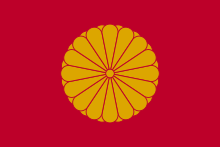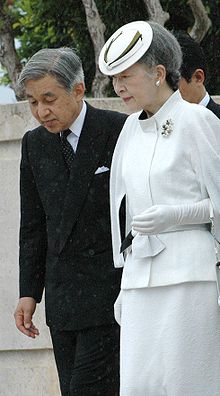Akihito
| Akihito 明仁 | |
|---|---|
 | |
| 125th Emperor of Japan | |
| Reign | 7 January 1989 – present (35 years, 219 days) |
| Enthronement | 12 November 1990 |
| Predecessor | Hirohito |
| Heir apparent | Naruhito, Crown Prince of Japan |
| Prime Ministers | |
| Spouse | Empress Michiko |
| Issue | Naruhito, Prince Hiro Fumihito, Prince Aya Sayako, Princess Nori |
| House | Imperial House of Japan |
| Father | Emperor Hirohito |
| Mother | Empress Kōjun |
| Religion | Shinto |
| Occupation | Emperor, ichthyologist |
Akihito (明仁, born 23 December 1933) is the current Emperor of Japan (天皇, tennō), and the 125th emperor according to Japan's traditional order of succession. He acceded to the throne in 1989.
Name
In Japan, the emperor is never referred to by his given name, but rather is referred to as "His Imperial Majesty the Emperor" which may be shortened to "His Imperial Majesty" (陛下, heika). In writing, the emperor is also referred to formally as "The Reigning Emperor" (今上天皇, kinjō tennō). The Era of Akihito's reign bears the name "Heisei" (平成), and according to custom he will be renamed "Emperor Heisei" (平成天皇 Heisei tennō; see "posthumous name") by order of the cabinet after his death. At the same time, the name of the next era under his successor will also be established.[1]
Biography

Akihito is the eldest son and the fifth child of Emperor Hirohito (the Showa Emperor) and Empress Kōjun. Titled Prince Tsugu (継宮, Tsugu-no-miya) as a child, he was raised and educated by his private tutors and then attended the elementary and secondary departments of the Peers' School (Gakushuin) from 1940 to 1952.[2] Unlike his predecessors in the Imperial Family, he did not receive a commission as an Army officer, at the request of his father, Hirohito.
During the American firebombing raids on Tokyo in March 1945, he and his younger brother, HIH Prince Masahito, were evacuated from the city. During the American occupation of Japan following World War II, Prince Akihito was tutored in English and Western manners by Elizabeth Gray Vining. He briefly studied at the Department of Political Science at Gakushuin University in Tokyo, though he never received a degree. Although he was Heir-Apparent to the Chrysanthemum Throne from the moment of his birth, his formal Investiture as Crown Prince (立太子礼, Rittaishi-no-rei) was held at the Tokyo Imperial Palace on 10 November 1952. In June 1953, Crown Prince Akihito represented Japan at the coronation of Queen Elizabeth II in London.[2]
Then-Crown Prince Akihito and Crown Princess Michiko made official visits to thirty-seven countries. As an Imperial prince, Akihito compared the role of Japanese royalty to that of a robot; and he expressed the hope that he would like to help in bringing the Imperial family closer to the people of Japan.[3]
After the death of Emperor Hirohito on 7 January 1989, the crown prince received the succession (senso).[4] Emperor Akihito formally acceded to the throne (sokui)[4] on 12 November 1990.[2] In 1998, during a state visit to the United Kingdom, he was invested with The Most Noble Order of the Garter.
On 23 December 2001, during his annual birthday meeting with reporters, the Emperor, in response to a reporter's question about tensions with Korea, remarked that he felt a kinship with Koreans and went on to explain that in the Shoku Nihongi the mother of Emperor Kammu (736–806) is related to Muryeong of Korea, King of Baekje.[5]
Emperor Akihito underwent surgery for prostate cancer in January 2003.[6] Since succeeding to the throne, Emperor Akihito has made an effort to bring the Imperial Family closer to the Japanese people. The Emperor and Empress of Japan have made official visits to eighteen countries, as well as all forty-seven Prefectures of Japan.[2]
In response to the 2011 earthquake, tsunami and nuclear crisis, the Emperor made a rare televised appearance[7] urging his people not to give up hope and to help each other.
Marriage and children
 |
On 10 April 1959, he married Michiko Shōda (born 24 October 1934), the eldest daughter of Hidesaburo Shōda, the president and later honorary chairman of Nisshin Flour Milling Company.[2][8] The new Crown Princess was the first commoner to marry into the imperial family. The Emperor and the Empress have three children:
- HIH The Crown Prince Naruhito (b. 23 February 1960, titled Hiro-no-miya or Prince Hiro),
- HIH The Prince Akishino (Fumihito, b. 30 November 1965, titled Aya-no-miya or Prince Aya) and
- Sayako Kuroda, formerly HIH The Princess Sayako (titled Nori-no-miya or Princess Nori, b. 18 April 1969).[2]
Official functions

Despite being strictly constrained by his constitutional position, he also issued several wide-ranging statements of remorse to Asian countries, for their suffering under Japanese occupation, beginning with an expression of remorse to China made in April 1989, three months after the death of his father, Emperor Hirohito.
In June 2005, the Emperor visited the US territory of Saipan, the site of a battle in World War II from 15 June to 9 July 1944 (Battle of Saipan). Accompanied by Empress Michiko, he offered prayers and flowers at several memorials, honoring not only the Japanese who died, but also American soldiers, Korean laborers, and local islanders. It was the first trip by a Japanese monarch to a World War II battlefield abroad. The Saipan journey was received with high praise by the Japanese people, as were the Emperor's visits to war memorials in Tokyo, Hiroshima, Nagasaki, and Okinawa in 1995.
On 6 September 2006, the Emperor celebrated the birth of his first grandson, Prince Hisahito, the third child of the Emperor's younger son. Prince Hisahito is the first male heir born to the Japanese imperial family in 41 years (since his father Prince Akishino) and could avert a possible succession crisis as the Emperor's elder son, the Crown Prince, has only one daughter, Princess Aiko. Under Japan's current male-only succession law, Princess Aiko is not eligible for the throne. The birth of Prince Hisahito could mean that proposed changes to the law to allow Aiko to ascend the Chrysanthemum Throne will not go through after being temporarily shelved following the announcement of Princess Kiko's third pregnancy in February 2006.
Ichthyological research
In extension of his father's interest in marine biology, the Emperor is a published ichthyological researcher, and has specialized studies within the taxonomy of the family Gobiidae.[9] He has written papers for scholarly journals, namely Gene and the Japanese Journal of Ichthyology.[10]
He has also written papers about the history of science during the Edo and Meiji eras, which were published in Science[11] and Nature.[12] In 2005, a newly described goby was named Exyrias akihito in his honour.
Awards

National
- Collar and Grand Cordon of the Supreme Order of the Chrysanthemum
- Grand Cordon of The Order of the Rising Sun with the Paulownia Blossoms (renamed Grand Cordon of The Order of the Paulownia Flowers from 2003)
- Grand Cordon of the Order of the Sacred Treasure
- Order of Culture
- The Golden Medal of Merit of the Japanese Red Cross
- The Golden Medal of Honorary Member of the Japanese Red Cross
International
Other Awards
Ancestors
| Family of Akihito | ||||||||||||||||||||||||||||||||||||||||||||||||||||||||||||||||||||||||||||||||||||||||||||||||||||||||||||||||||||||||||||||||||||||||||||||||||||||||||||||||||||||||||||||||||||||||||||||||||||||||||||||||||||||||||||||||||||||||||||||||||||||||||||||||||||||||||||||||||||||||||||||||||||||||||||||||||||||||||||||||||||||||||||||||||||||||||||||||||||||||||||||||||||||||||||||||||||||||||||||||||||||||||||||||||||||||||||||||||||||||||||||||||||||||||||||||||||||||||||||||||||||||||||||||||||||||||||||||||||||||||||||||||||||||||||||||||||||||||||||||||||||||||||||||
|---|---|---|---|---|---|---|---|---|---|---|---|---|---|---|---|---|---|---|---|---|---|---|---|---|---|---|---|---|---|---|---|---|---|---|---|---|---|---|---|---|---|---|---|---|---|---|---|---|---|---|---|---|---|---|---|---|---|---|---|---|---|---|---|---|---|---|---|---|---|---|---|---|---|---|---|---|---|---|---|---|---|---|---|---|---|---|---|---|---|---|---|---|---|---|---|---|---|---|---|---|---|---|---|---|---|---|---|---|---|---|---|---|---|---|---|---|---|---|---|---|---|---|---|---|---|---|---|---|---|---|---|---|---|---|---|---|---|---|---|---|---|---|---|---|---|---|---|---|---|---|---|---|---|---|---|---|---|---|---|---|---|---|---|---|---|---|---|---|---|---|---|---|---|---|---|---|---|---|---|---|---|---|---|---|---|---|---|---|---|---|---|---|---|---|---|---|---|---|---|---|---|---|---|---|---|---|---|---|---|---|---|---|---|---|---|---|---|---|---|---|---|---|---|---|---|---|---|---|---|---|---|---|---|---|---|---|---|---|---|---|---|---|---|---|---|---|---|---|---|---|---|---|---|---|---|---|---|---|---|---|---|---|---|---|---|---|---|---|---|---|---|---|---|---|---|---|---|---|---|---|---|---|---|---|---|---|---|---|---|---|---|---|---|---|---|---|---|---|---|---|---|---|---|---|---|---|---|---|---|---|---|---|---|---|---|---|---|---|---|---|---|---|---|---|---|---|---|---|---|---|---|---|---|---|---|---|---|---|---|---|---|---|---|---|---|---|---|---|---|---|---|---|---|---|---|---|---|---|---|---|---|---|---|---|---|---|---|---|---|---|---|---|---|---|---|---|---|---|---|---|---|---|---|---|---|---|---|---|---|---|---|---|---|---|---|---|---|---|---|---|---|---|---|---|---|---|---|---|---|---|---|---|---|---|---|---|---|---|---|---|---|---|---|---|---|---|---|---|---|---|---|---|---|---|---|---|---|---|---|---|---|---|---|---|---|---|---|---|---|---|---|---|---|---|---|---|---|---|---|---|---|---|---|---|---|---|---|---|---|---|---|---|---|---|---|---|---|---|---|---|---|---|---|---|---|---|---|---|---|---|---|---|---|---|---|---|---|---|---|---|---|---|---|---|---|---|---|---|---|---|---|---|---|---|---|---|---|---|---|---|---|---|---|---|---|---|---|---|---|---|---|---|---|---|---|---|---|---|---|---|---|---|---|---|---|---|---|---|---|---|---|---|---|---|---|---|---|---|---|---|---|---|---|---|---|---|---|---|---|---|---|---|---|---|---|---|
| ||||||||||||||||||||||||||||||||||||||||||||||||||||||||||||||||||||||||||||||||||||||||||||||||||||||||||||||||||||||||||||||||||||||||||||||||||||||||||||||||||||||||||||||||||||||||||||||||||||||||||||||||||||||||||||||||||||||||||||||||||||||||||||||||||||||||||||||||||||||||||||||||||||||||||||||||||||||||||||||||||||||||||||||||||||||||||||||||||||||||||||||||||||||||||||||||||||||||||||||||||||||||||||||||||||||||||||||||||||||||||||||||||||||||||||||||||||||||||||||||||||||||||||||||||||||||||||||||||||||||||||||||||||||||||||||||||||||||||||||||||||||||||||||||
Patrilineal descent
| Family of Akihito |
|---|
|
Akihito's patriline is the line from which he is descended father to son. Patrilineal descent is the principle behind membership in royal houses, as it can be traced back through the generations, which means that Akihito is a member of the Imperial House of Japan.
|
See also
- The Emperor's Birthday
- Imperial Household Agency
- Imperial Household of Japan
- Japanese era name
- List of Japanese Emperors
- List of longest reigning current monarchs
References
- ^ "National Day of Japan to be celebrated". Embassy of Japan in Pakistan. 2007-12-07. Retrieved 2007-12-28.
{{cite news}}: Cite has empty unknown parameter:|coauthors=(help) - ^ a b c d e f "Their Majesties the Emperor and Empress". Imperial Household Agency. 2002. Archived from the original on 2007-12-01. Retrieved 2007-12-28.
- ^ "Those Apprentice Kings and Queens Who May -- One Day -- Ascend a Throne," New York Times. 14 November 1971.
- ^ a b Varley, H. Paul. (1980). Jinnō Shōtōki, p. 44.
- ^ "Press Conference on the Occasion of His Majesty's Birthday". Imperial Household Agency. Archived from the original on 2008-05-25. Retrieved 2008-07-07.
{{cite web}}: Text "2001-12-18" ignored (help) - ^ "Akihito has successful cancer operation". BBC News. British Broadcasting Corporation. 2003-01-18. Retrieved 2007-12-28.
{{cite news}}: Cite has empty unknown parameter:|coauthors=(help) - ^ "Six days later, Japanese still confronting magnitude of quake crisis". CNN.
- ^ Fukada, Takahiro, "Emperor — poise under public spotlight", Japan Times, November 24, 2009, p. 3.
- ^ Hamilton, Alan. "Palace small talk problem solved: royal guest is a goby fish fanatic," The Times (London). 30 May 2007
- ^ PubMed Search Results
- ^ Akihito (1992). "Early cultivators of science in Japan". Science. 258 (5082): 578–80. doi:10.1126/science.1411568. PMID 1411568.
{{cite journal}}: Unknown parameter|month=ignored (help) - ^ His Majesty The Emperor of Japan (2007). "Linnaeus and taxonomy in Japan". Nature. 448 (7150): 139–140. doi:10.1038/448139a. PMID 17632886.
{{cite journal}}: Unknown parameter|month=ignored (help) - ^ "Akihito". Bearers of decorations. president.ee. Retrieved 18 January 2011.
- ^ Decree 1K-974
- ^ OPS.gov.ph
External links
- The Japanese Imperial Household Agency Homepage, press conferences, extensive biography, official duties and public activities.
- Complete transcript and audio mp3 and video of 'Do Not Lose Hope' Address to the Nationat AmericanRhetoric.com
- 1933 births
- Living people
- Japanese emperors
- Reigning monarchs
- Current national leaders
- Japanese ichthyologists
- Knights of the Elephant
- Knights of the Golden Fleece
- Extra Knights Companion of the Garter
- Grand Cordons of the Order of Leopold (Belgium)
- Recipients of the Order of the White Eagle (Poland)
- Grand Croix of the Légion d'honneur
- Recipients of the Order of the Nile
- Gakushuin University alumni
- Grand Crosses of the Order of the Redeemer
- Recipients of the Order of the Chrysanthemum
- Recipients of the Order of the Rising Sun
- Recipients of the Order of the Sacred Treasure
- Recipients of the Order of Culture
- Recipients of the Order of the Supreme Sun
- Grand Collars of the Order of the Southern Cross
- Recipients of the Order of Merit (Chile)
- Recipients of the Order of the White Lion
- Recipients of the Order of Solomon
- Commanders Grand Cross with Collar of the Order of the White Rose of Finland
- Recipients of the Order of the Falcon
- Knights Grand Cross with Collar of the Order of Merit of the Italian Republic
- Recipients of the Order of the Three Stars, 1st Class
- Recipients of the Order of Vytautas the Great
- Recipients of the Order of the Gold Lion of the House of Nassau
- Recipients of the Order of the Aztec Eagle
- Knights Grand Cross of the Order of the Netherlands Lion
- Grand Crosses Special Class of the Order of Merit of the Federal Republic of Germany
- Knights Grand Cross with Collar of the Order of St. Olav
- Recipients of the Nishan-e-Pakistan
- Recipients of the Order of Manuel Amador Guerrero
- Recipients of the Order of the Sun (Peru)
- Recipients of the Philippine Legion of Honor
- Recipients of the Order of the Lion (Senegal)
- Recipients of the Order of the Seraphim
- Honorary Knights Grand Cross of the Royal Victorian Order
- Recipients of the Order of the Yugoslav Star
- Knights of the Order of the Rajamitrabhorn
- Knights of the Order of the Royal House of Chakri
- Recipients of the Collar of the Order of the Cross of Terra Mariana

